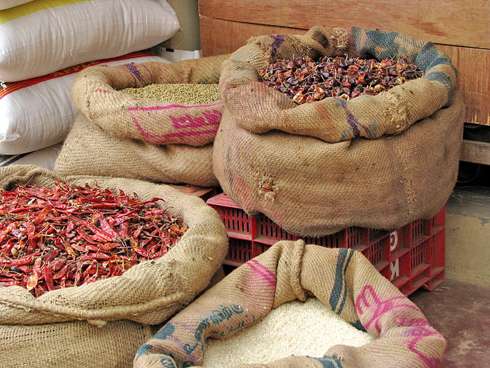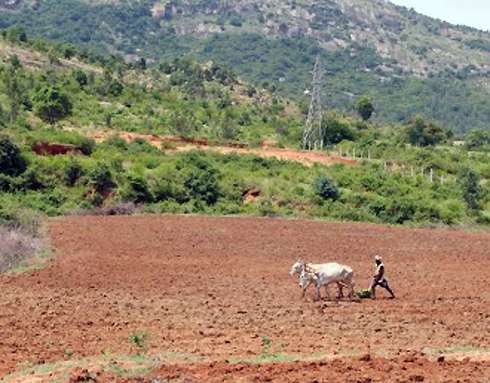The 15th Lok Sabha is close to the end of its tenure. Two big legislations that propose major reforms in food security and land acquisition - one introduced in the Lok Sabha and the other listed for discussion - await a nod from Parliament. Both Bills have been scrutinised by Standing Committees and Groups of Ministers, and have gone through various rounds of iterations and amendments. In this article, we take a look at how these Bills envision these reforms.
Food for all
Let us first take a look at The Food Security Bill, 2011 that was introduced in Parliament on 6 May, 2013. The Bill aims to make the right to food a statutory right. It proposes to use the existing PDS to deliver food grain to 75 per cent of the rural and 50 per cent of the urban population. However, the Bill also allows for cash transfers and food coupons in lieu of grains as mechanisms to ensure food security. While the PDS is known to suffer from leakage as high as 40 per cent, cash transfers and food coupons could expose beneficiaries to volatility and price inflation. Each method of delivery would have its own implications, both financial and otherwise.
The Bill does not universalise food entitlements. It classifies the population into two categories of beneficiaries, to be identified by the centre and states. Mechanisms that aim to target benefits to certain sections of the population have been prone to large inclusion and exclusion errors. A 2009 expert group study estimated that about 61 per cent of the eligible population was excluded from the BPL list while 25 per cent of APL households were included in the BPL list. With such large errors in identification already plaguing the system, it is unclear how the implementation of the Bill would work around these issues.

Pic: McKay Savage via Wikimedia
A Bill that aims to deliver food security to a large section of the country would have significant financial implications. Costs shall be shared between the centre and states. Although the centre shall provide some assistance, states will have to bear a significant financial burden on account of implementation. It is unclear whether Parliament can require states to allocate funds without encroaching on the powers of state legislative assemblies. If a state chooses not to allocate the necessary funds or does not possess the funds to do so, implementation of the Bill could be seriously affected. The Standing Committee examining the Bill had recommended that an independent body, such as the Finance Commission, should be consulted regarding additional funds to be borne by states. The Right to Education Act which entails similar centre-state sharing of funds provides for such consultation with the Finance Commission.
Another contentious issue is the cost of implementing the Bill. The Bill estimates the cost at Rs 95,000 crore. However, experts have made varying estimates on the costs ranging from Rs 2 lakh crore to Rs 3.5 lakh crore. Ashok Gulati, Chairman of the Commission for Agricultural Costs and Prices estimated the cost at 2 lakh crore per year whereas the Minister of Food, K.V. Thomas was reported to have estimated the cost at Rs 3.5 lakh crore.

•
Amartya Sen on Food Security Bill
•
One acre forward, two back
Displacement for Development
The Land Acquisition Bill, 2011 proposes to repeal the 1894 Act, by combining acquisition and rehabilitation and resettlement (R&R) in a single comprehensive law. The Bill aims to promote land acquisition for development while providing adequate compensation and rehabilitation for the forcible nature of acquisition. How does the Bill do this? It allows for the acquisition of land for a certain number of ‘public purposes’ which include defence, infrastructure, development schemes, manufacturing zones and urbanisation. The term ‘public purpose’ existed in the 1894 Act and previous version of the Bill. The big change from the 1894 Act is that the current Bill does not contain a catch-all purpose that allows acquisition for projects that are ‘for the good of the general public’. The 2007 Bill had narrowed public purpose to include only defence, infrastructure, and private projects for contiguity reasons, thus preventing acquisition for urbanisation, dams, etc. The list has been widened under the current Bill.

File pic
Once the purpose of an acquisition has been determined, land can be acquired for use by the government, a private company or a public-private-partnership. In order to balance the forcible nature of these acquisitions, the Bill makes it necessary to take the consent of landowners in certain cases. However, the Bill distinguishes between a private company and a PSU on the issue of consent. If a PSU acquires land for a public purpose, consent of owners will not be necessary. Yet, if land is acquired for the same purpose by a private company or a PPP, then consent of 80% and 70% of landowners respectively will be necessary. It is unclear though why the Bill poses different conditions for consent based on the ownership of the company.
In addition, the Bill aims to compensate landowners through a formula that differs for land in urban and rural areas. In urban areas, compensation has been fixed at twice the average market value of land, based on recently reported transactions in the vicinity. The amount of compensation increases to up to four times for land in rural areas, depending on the proximity of land to urban centres. The Bill provides no rationale for how these numbers have been determined. A possible reason for this doubling could be to compensate for under-reporting of the transacted price in registration deeds, a common practice in land acquisition today. However, this calculation may not provide an accurate estimation of the value of land.
The process of acquisition also involves a Social Impact Assessment (SIA) of all projects. The Bill does not specify any minimum threshold of land for which an SIA must be conducted. This implies that an SIA would be necessary even if an acre of land was being acquired to build a bus shelter. Requiring an SIA for each and every project could lead to large delays in implementation of small acquisitions for useful projects.
The Bill exempts acquisitions for projects such as national highways, railways and atomic energy. These acquisitions are governed under other Acts which envision their own compensation and R&R framework. There are differences between the Bill and these Acts in the way they address such issues. There has been no clarification, however, on why compensation should differ for a landowner simply because his land is being acquired for a national highway versus an urbanisation project.
Both the land and food legislation propose key reforms to the existing frameworks. Their passage in Parliament will depend on the ability of the government to build consensus on the above issues. In case of land acquisition, the law will be evaluated on its ability to balance the need for acquiring land with compensation and rehabilitation of affected people. The biggest challenge for the Food Security Bill will be to ensure food and nutritional security for the poor. It remains to be seen how Parliament debates these two historic legislations.
